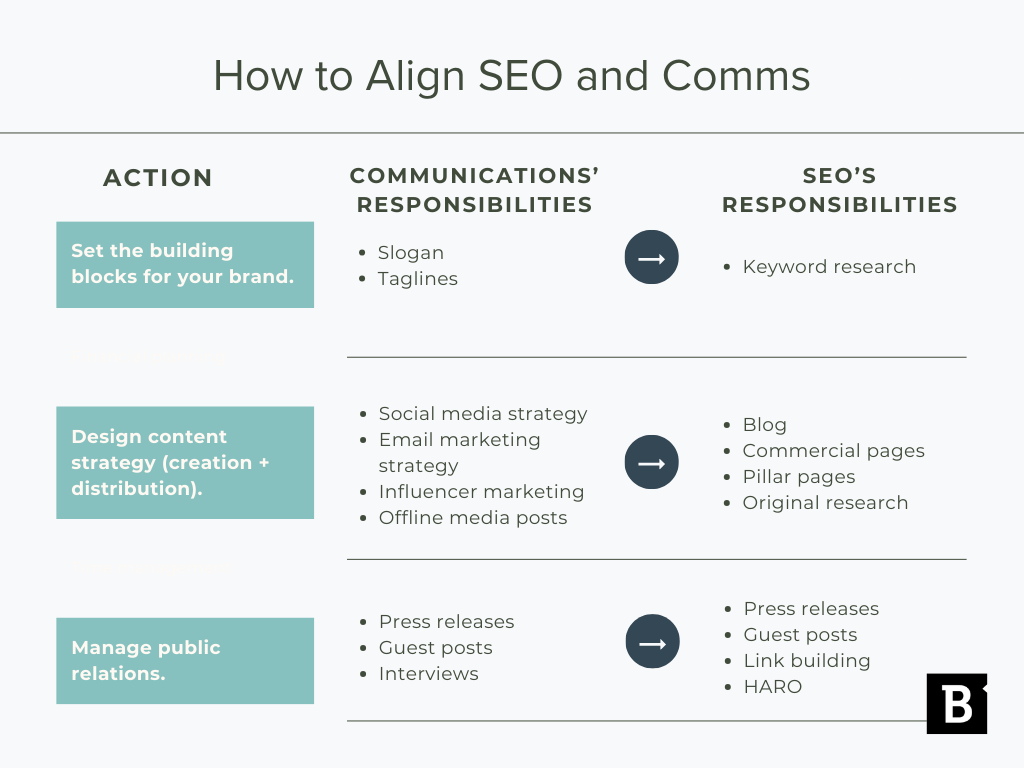When you work on SEO, it’s easy to get lost — more often than people like to admit — in the weeds.
Does this keyword have traffic potential? Is it topically relevant? Is the keyword difficulty too high?
All of these matter, indeed, but before you start drilling down into the details of your keyword selection, there’s something else you need to take into account: your company’s external communications strategy.
In this article, we’ll dive into the benefits of aligning your SEO and comms strategies, the risks of not doing it and the steps you need to follow to ensure all your marketing activities are lined up correctly.
Understanding SEO and Communications
First things first: What is SEO and what does it have to do with communications? Both of these activities fall within the realm of marketing processes a company needs to do to achieve its business objectives.
SEO (Search Engine Optimization) focuses on increasing the company’s visibility on search engines by creating and optimizing content. A comprehensive SEO strategy is usually composed of on-page (keyword research, content creation and optimization, etc.) and off-page (link building, guest posting, directory management, etc.) tactics.
Communications refers to the transfer or exchange of information between a company and external entities (potential and current customers, media outlets, etc.). Depending on the type of business and its goals, budget, and target audience, companies can make use of social media, email marketing, blogging, print media, traditional and digital advertising, and more.
There are important differences between these two branches of marketing, but there’s one thing they share in common: Every activity related to SEO and communications leads to the transmission of information.
Conveying the right message consistently across different channels will depend on how aligned your strategies are.
Why Aligning SEO and Comms Is Crucial for Success
The success of your SEO campaign doesn’t depend entirely on your team’s efforts. Other marketing initiatives, like external communications, can influence for better or worse the outcome of your SEO projects.
When your SEO and communications strategies aren’t on the same page, it’s like trying to dance to different tunes: total chaos. You end up with a mishmash of branding, mixed messages and a whole lot of wasted effort.
To get the right message across and build a strong brand, these strategies need to be in sync. This way, your brand’s voice stays consistent wherever it shows up, grabbing your audience’s attention. Plus, it boosts your visibility online, makes you stand out from the crowd and improves your marketing’s ROI.
Remember: Success relies on everyone working together smoothly. Good communication and coordination across departments are essential to ensuring you’re all contributing to the same goals.
Strategies for a Successful Alignment
Now you know why your strategies need to work hand in hand. But, how do you achieve the so-called alignment? Worry not, fellow marketer. Here are a few strategies that will help you keep all your initiatives coordinated:
1. Straighten out your goals and target audiences.
It might sound obvious, but you and your team need to have clarity about the why’s and the who’s. Each medium you choose will have its own particular objective and its own KPIs. But in the end, they all have to contribute to the overall goal of the strategy.
For instance, let’s consider a lead generation campaign. While the specific goals may differ across platforms—such as driving traffic or capturing email sign-ups—the overarching aim remains the same: generating leads.
Similarly, when it comes to defining your target audience, consistency is key. Your marketing mix could include different approaches, like influencer marketing, PPC and guest posting. But, in the end, they all should contribute to creating a seamless and unified experience across all channels for your core audience. If you’re targeting two completely different personas, you risk sharing misaligned information and not hitting your goals.
2. Unify keywords across marketing materials.
Your brand’s style and tone of voice must be represented in a consistent manner across every single marketing material, whether it’s a LinkedIn post, an eBook, or your printed product catalog. A great way to ensure all your teams are speaking the same language is by creating a list of the most relevant terms to your business, as well as its allowed variations and the definite no-no’s. This step is crucial for any SEO and content marketing campaign, so make sure to do it properly. You don’t want to be the type of brand that uses a completely different tone on every single channel:

3. Iron out content creation and distribution from the beginning,
Do you remember those school days when you had to do a group presentation and, instead of working together, you and your team just split the content between the team members? Without fail, it ended up looking like a weird Frankenstein-experiment-Comic-Sans-sprinkled PowerPoint. That’s exactly how it looks when a brand does content marketing without a strategy. Does it mean you have to post exactly the same across all channels? Of course not! Each platform has its own preferred style and formats, but they all have to follow the same path (aka your overall goal). By doing this from the start, you’ll save time (and money!) because your teams will be able to create their deliverables by feeding on other team’s work.
4. Make offline and online mirror themselves.
Given the number of times I’ve seen companies failing to communicate consistently across digital and offline channels, I feel the need to repeat it: The messages you share online must be coherent with those you share offline. If your store is offering new products this season, make sure to update your Google Business Profile listing. Are you sharing discount coupons for your newsletter subscribers? Remind your physical visitors to subscribe (maybe have a QR code on the counter with a note like, “Scan here to subscribe for updates and special offers”). Are you hosting an onsite event to present your new products? Promote it on social.
Subscribe to
The Content Marketer
Get weekly insights, advice and opinions about all things digital marketing.
Thanks for subscribing! Keep an eye out for a Welcome email from us shortly. If you don’t see it come through, check your spam folder and mark the email as „not spam.“
How to Align SEO and Comms: Off-Page and On-Page SEO + Communications Examples
I’m fully aware that “aligning SEO and comms” can be a vague concept, so let’s drill down into the specifics with a few examples that will make things a lot easier for you.
For explanation purposes, we’ll talk about a hypothetical client. WoofLingo is an app that translates your dog’s barks into English. This is the first launch of the startup, so people don’t really know them and the product is completely brand-new.
To make sure their SEO tactics stay aligned with their communication strategy, the first two things they have to do are:
Once that’s set, they can move on to the next steps:

1. Set the building blocks for your brand.
To start things on the right foot you need to have clarity about your brand positioning. So, create a list of the key messages you want to communicate across all platforms.
These messages encapsulate the core ideas that define and differentiate your brand. The goal is to ultimately build your brand around them.
For WoofLingo, this could include statements like „Building better relationships with your dog through understanding“ or „Effective communication tools for connecting with your canine companion.“
Once these messages are established, it’s crucial to align them with terms that reflect and reinforce your brand’s positioning. This list of words should encompass concepts directly related to your products or services, while also excluding those that don’t align with your brand identity. While synonyms are common in most industries, certain sectors like legal and pharma require precise language.
For WoofLingo, the word list might include terms such as:
☑️
Dog translator
Dog-friendly
Canine communication
Dog behavior specialist
Canine linguistics
Puppy socialization
❌
Pet interpreter
Pet language decoder
Pet-friendly accommodations
Animal whisperer
Companion animal interpreter
Deciding early on what words align most closely with your desired brand positioning not only ensures consistency in messaging but also lays a solid foundation for SEO keyword research.
By aligning keywords with your brand’s mission and offerings from the outset, you avoid investing resources in positioning your brand with irrelevant or misaligned keywords.
2. Design the content strategy.
Content can come in many shapes and sizes, but it’s crucial that every single post ultimately contributes to the overall goal of the campaign. If you create a roadmap for creation and distribution from the start, it’ll be easier to keep everything coordinated.
For WoofLingo, this step could begin by creating the SEO content strategy. Based on the keyword research and the current state of the brand, most of the content will be focused on the top of the funnel.
To boost brand awareness, the company will create original research around dog owners’ most common pain points. WoofLingo’s team will collect data from surveys, polls, interviews or other methodologies, and create brand-new content based on it.
The results of this research can feed into the pillar pages and the press release. The right execution of this part of the process will help accelerate brand recognition, but it will also be extremely beneficial in terms of SEO since it can contribute to link building, improving rankings and driving referral traffic.
To complement these efforts it’s necessary to ensure that all pieces of content are promoted. For WoofLingo, the right digital channels are social media, email marketing and influencer marketing. Depending on the budget, the company can choose to reach out to offline outlets as well. In this case, printed magazines and newspapers could be a good option.
3. Manage public relations.
To make sure that WoofLingo’s SEO messaging is in line with their communications strategy, they need to think about public relations holistically. Instead of targeting one media outlet at a time, WoofLingo’s team has to take a moment to think of the different channels and formats they can use to reach a wider audience, while sharing the same message (see Action 1).
Additionally, by following this approach, they maximize their content’s ROI because the original research feeds the press release, a blog post inspires a guest post, the social media posts serve as an initial idea for interviews or HARO contributions, and so on.
Conclusion
Creating fully synced SEO and communications strategies shouldn’t be a rare unicorn; it should be the norm for every company. It doesn’t matter if you’re measuring clicks, ranking positions or brand mentions. In the end, we’re all striving to communicate the greatness of our products or services.
So, go ahead and let yourself out of your work bubble. Once you get a grasp of the bigger picture, you’ll see how it’s all connected.





